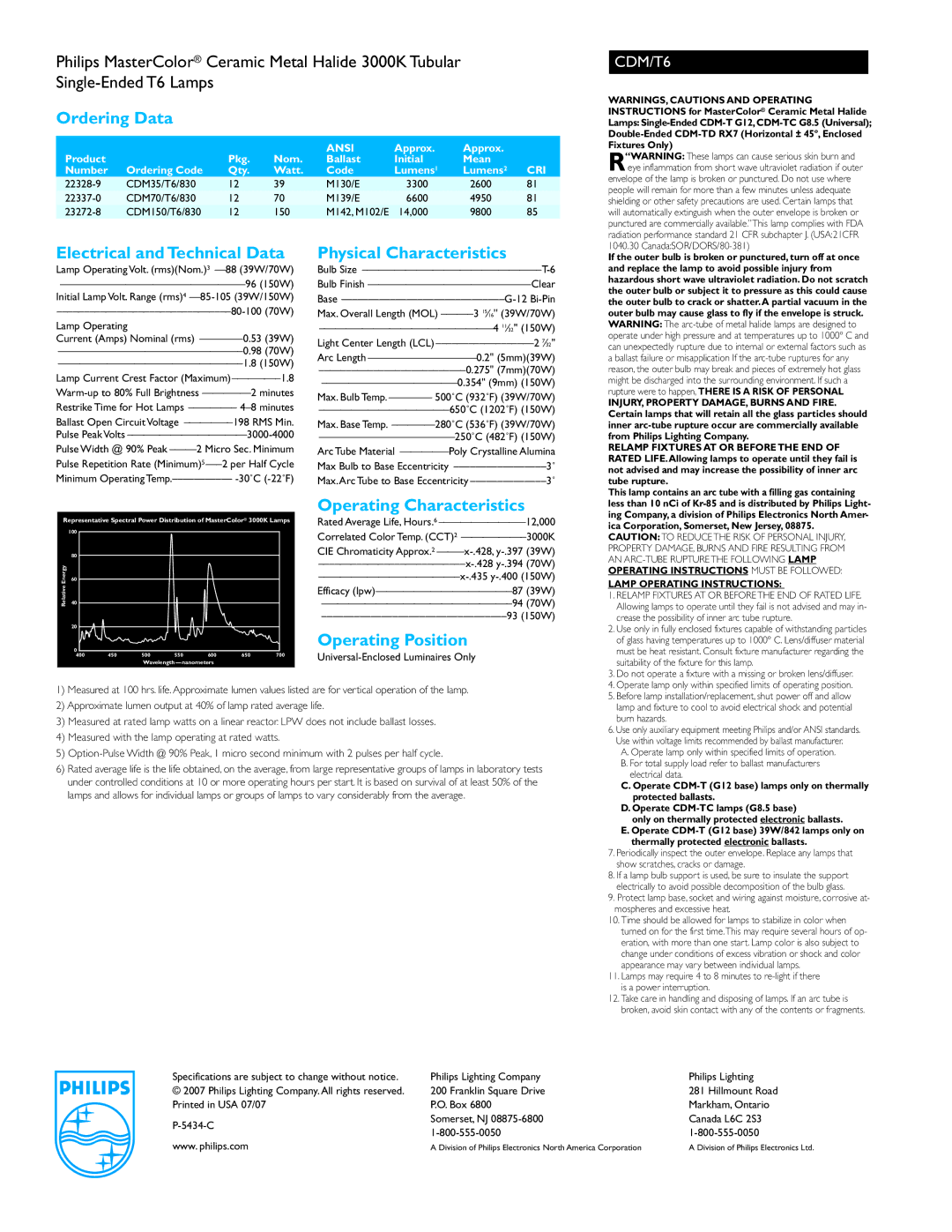
Philips MasterColor® Ceramic Metal Halide 3000K Tubular
Ordering Data
|
|
|
| ANSI | Approx. | Approx. |
|
Product |
| Pkg. | Nom. | Ballast | Initial | Mean |
|
Number | Ordering Code | Qty. | Watt. | Code | Lumens1 | Lumens2 | CRI |
CDM35/T6/830 | 12 | 39 | M130/E | 3300 | 2600 | 81 | |
CDM70/T6/830 | 12 | 70 | M139/E | 6600 | 4950 | 81 | |
CDM150/T6/830 | 12 | 150 | M142, M102/E | 14,000 | 9800 | 85 |
CDM/T6
WARNINGS, CAUTIONS AND OPERATING INSTRUCTIONS for MasterColor® Ceramic Metal Halide
R“WARNING: These lamps can cause serious skin burn and eye inflammation from short wave ultraviolet radiation if outer
envelope of the lamp is broken or punctured. Do not use where people will remain for more than a few minutes unless adequate shielding or other safety precautions are used. Certain lamps that will automatically extinguish when the outer envelope is broken or punctured are commercially available.”This lamp complies with FDA radiation performance standard 21 CFR subchapter J. (USA:21CFR 1040.30
Electrical andTechnical Data
Lamp Operating Volt. (rms)(Nom.)3
Current (Amps) Nominal (rms)
Representative Spectral Power Distribution of MasterColor® 3000K Lamps
| 100 |
|
|
|
|
|
|
RelativeEnergy | 80 |
|
|
|
|
|
|
40 |
|
|
|
|
|
| |
| 60 |
|
|
|
|
|
|
| 20 |
|
|
|
|
|
|
| 0 | 450 | 500 | 550 | 600 | 650 | 700 |
| 400 |
Wavelength — nanometers
Physical Characteristics
Bulb Size
Base
–––––––––––––––––––––––––––0.275" (7mm)(70W)
Max.Arc Tube to Base Eccentricity
Operating Characteristics
Rated Average Life, Hours.6
Correlated Color Temp. (CCT)2
CIE Chromaticity Approx.2
Operating Position
Universal-Enclosed Luminaires Only
If the outer bulb is broken or punctured, turn off at once and replace the lamp to avoid possible injury from hazardous short wave ultraviolet radiation. Do not scratch the outer bulb or subject it to pressure as this could cause the outer bulb to crack or shatter.A partial vacuum in the outer bulb may cause glass to fly if the envelope is struck. WARNING: The
INJURY,PROPERTY DAMAGE, BURNS AND FIRE. Certain lamps that will retain all the glass particles should inner
RELAMP FIXTURES AT OR BEFORETHE END OF RATED LIFE.Allowing lamps to operate until they fail is not advised and may increase the possibility of inner arc tube rupture.
This lamp contains an arc tube with a filling gas containing less than 10 nCi of
CAUTION: TO REDUCE THE RISK OF PERSONAL INJURY, PROPERTY DAMAGE, BURNS AND FIRE RESULTING FROM AN
LAMP OPERATING INSTRUCTIONS:
1. RELAMP FIXTURES AT OR BEFORE THE END OF RATED LIFE. |
Allowing lamps to operate until they fail is not advised and may in- |
crease the possibility of inner arc tube rupture. |
2. Use only in fully enclosed fixtures capable of withstanding particles |
of glass having temperatures up to 1000º C. Lens/diffuser material |
must be heat resistant. Consult fixture manufacturer regarding the |
suitability of the fixture for this lamp. |
3. Do not operate a fixture with a missing or broken lens/diffuser. |
4. Operate lamp only within specified limits of operating position. |
1)Measured at 100 hrs. life. Approximate lumen values listed are for vertical operation of the lamp.
2)Approximate lumen output at 40% of lamp rated average life.
3)Measured at rated lamp watts on a linear reactor. LPW does not include ballast losses.
4)Measured with the lamp operating at rated watts.
5)
6)Rated average life is the life obtained, on the average, from large representative groups of lamps in laboratory tests under controlled conditions at 10 or more operating hours per start. It is based on survival of at least 50% of the lamps and allows for individual lamps or groups of lamps to vary considerably from the average.
5. Before lamp installation/replacement, shut power off and allow |
lamp and fixture to cool to avoid electrical shock and potential |
burn hazards. |
6. Use only auxiliary equipment meeting Philips and/or ANSI standards. |
Use within voltage limits recommended by ballast manufacturer. |
A. Operate lamp only within specified limits of operation. |
B. For total supply load refer to ballast manufacturers |
electrical data. |
C. Operate |
protected ballasts. |
D. Operate |
only on thermally protected electronic ballasts. |
E. Operate |
thermally protected electronic ballasts. |
7. Periodically inspect the outer envelope. Replace any lamps that |
show scratches, cracks or damage. |
8. If a lamp bulb support is used, be sure to insulate the support |
electrically to avoid possible decomposition of the bulb glass. |
9. Protect lamp base, socket and wiring against moisture, corrosive at- |
mospheres and excessive heat. |
10. Time should be allowed for lamps to stabilize in color when |
turned on for the first time.This may require several hours of op- |
eration, with more than one start. Lamp color is also subject to |
change under conditions of excess vibration or shock and color |
appearance may vary between individual lamps. |
11. Lamps may require 4 to 8 minutes to |
is a power interruption. |
12. Take care in handling and disposing of lamps. If an arc tube is |
broken, avoid skin contact with any of the contents or fragments. |
Specifications are subject to change without notice. © 2007 Philips Lighting Company. All rights reserved. Printed in USA 07/07
www. philips.com
Philips Lighting Company | Philips Lighting |
200 Franklin Square Drive | 281 Hillmount Road |
P.O. Box 6800 | Markham, Ontario |
Somerset, NJ | Canada L6C 2S3 |
A Division of Philips Electronics North America Corporation | A Division of Philips Electronics Ltd. |
